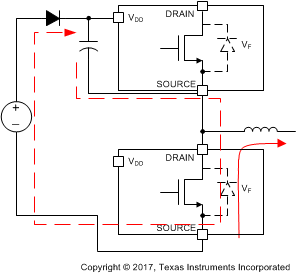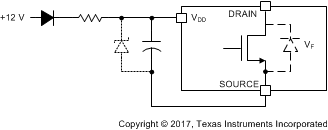SNOSD81B September 2018 – January 2020 LMG3410R050 , LMG3411R050
PRODUCTION DATA.
- 1 Features
- 2 Applications
- 3 Description
- 4 Revision History
- 5 Pin Configuration and Functions
- 6 Specifications
- 7 Parameter Measurement Information
-
8 Detailed Description
- 8.1 Overview
- 8.2 Functional Block Diagram
- 8.3 Feature Description
- 8.4 Safe Operation Area (SOA)
- 9 Application and Implementation
- 10Power Supply Recommendations
- 11Layout
- 12Device and Documentation Support
- 13Mechanical, Packaging, and Orderable Information
Package Options
Mechanical Data (Package|Pins)
- RWH|32
Thermal pad, mechanical data (Package|Pins)
Orderable Information
10.2.2 Managing the Bootstrap Voltage
In a synchronous buck, totem-pole PFC, or other converter where the low-side switch occasionally operates in third-quadrant mode, it is important to consider the bootstrap supply. During the dead time, the bootstrap supply charges through a path that includes the third-quadrant voltage drop of the low-side LMG341xR050. This third-quadrant drop can be large, which may over-charge the bootstrap supply in certain conditions. The VDD supply of LMG341xR050 must not exceed 18 V in bootstrap operation.
 Figure 22. Charging Path for Bootstrap Diode
Figure 22. Charging Path for Bootstrap Diode The recommended bootstrap supply connection includes a bootstrap diode and a series resistor with an optional zener as shown in Figure 23. The series resistor limits the charging current at startup and when the low-side device is operating in third-quadrant mode. This resistor must be chosen to allow sufficient current to power the LMG341xR050 at the desired operating frequency. At 100 kHz operation, a value of approximately 5.1 Ω is recommended. At higher frequencies, this resistor value should be reduced or the resistor omitted entirely to ensure sufficient supply current.
 Figure 23. Suggested Bootstrap Regulation Circuit
Figure 23. Suggested Bootstrap Regulation Circuit Using a series resistor with the bootstrap supply will create a charging time constant in conjunction with the bypass capacitance on the order of a microsecond. When the dead time, or third-quadrant conduction time, is much lower than this time constant, the bootstrap voltage will be well-controlled and the optional zener clamp in Figure 23 will not be necessary. If a large deadtime is needed, a 14-V zener diode can be used in parallel with the VDD bypass capacitor to prevent damaging the high-side LMG341xR050.